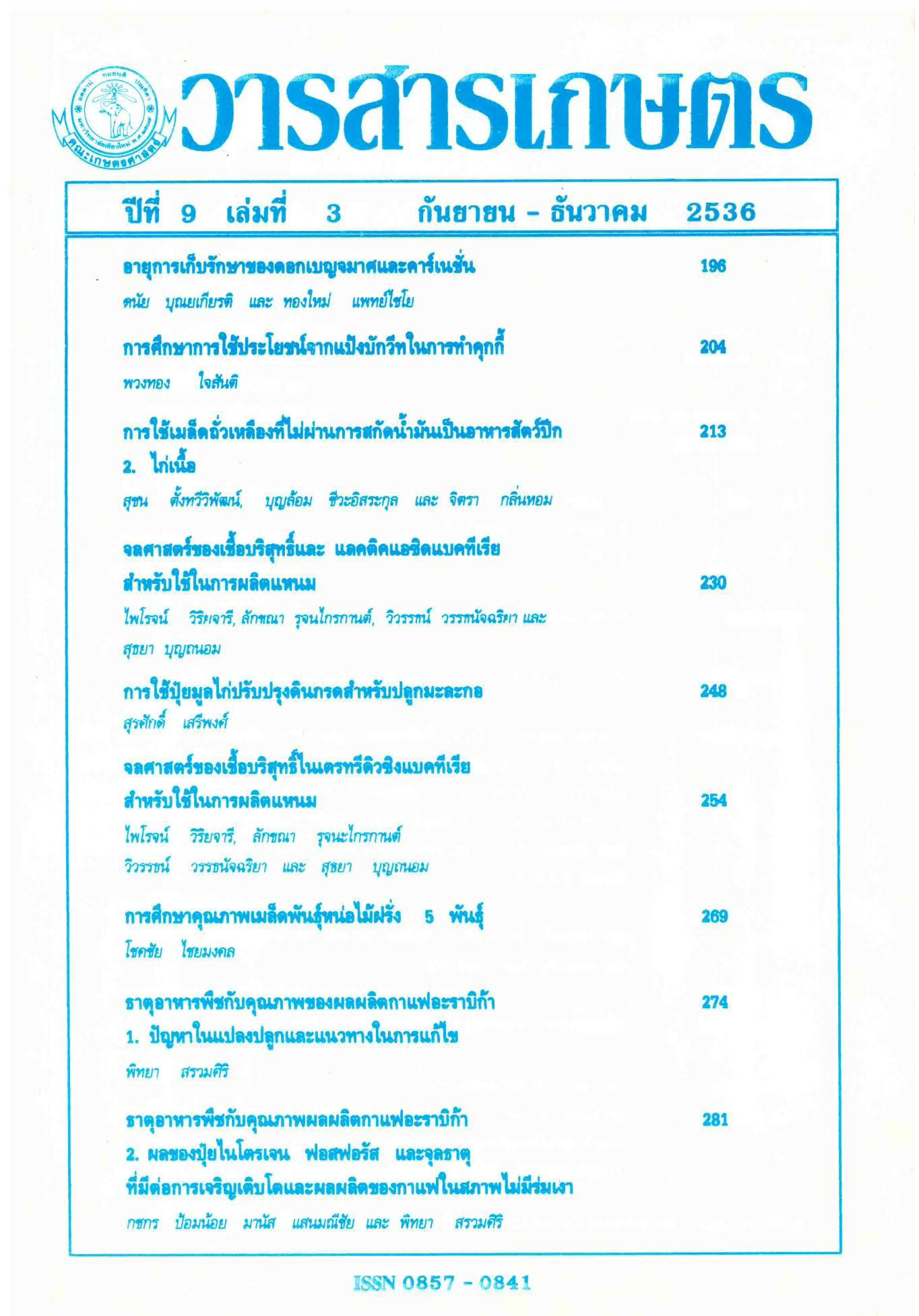จลศาสตร์ของเชื้อบริสุทธิ์ไนเตรทรีดิวซิงแบคทีเรียสำหรับใช้ในการผลิตแหนม
Main Article Content
บทคัดย่อ
Micrococcus varians เป็นไนเตรทรีดิวซิงแบคทีเรียที่ต้องการคลูโคสเป็นสารอาหารสำหรับใช้ในการเจริญเติบโตของเชลและการทำกิจกรรมต่างๆ ดังนั้น การศึกษาจลศาสตร์ของเชื้อดังกล่าวใน model System จึงนำกลูโคสมาใช้เป็นปัจจัยสำคัญ โดยแปรที่ระดับร้อยละ 0.2-0.40 ในเวลา 48 ชั่วโมง ของการหมักโดย M.varians จากการทดลองพบว่า M.varians มีค่า menimum specificgrowth rate (um) เท่ากับ 0.2534 ชั่วโมง-1 และ saturation constant (Ks) มีค่าร้อยละ 0.1799 อย่างไรก็ตาม M.varians สามารถผลิตกรดคิดเทียบกรดแลคติคได้น้อยมาก จึงมีผลให้ค่าความเป็นกรดด่าง (pH) ค่อนข้างสูง สำหรับกิจกรรมในการรีดิวสารประกอบไนเตรท พบว่า สามารถเปลี่ยนให้เป็นสารประกอบไนไตรท์ได้มากถึงร้อยละ 80 ในช่วง 12-18 ชั่วโมงแรกของการหมัก ทั้งนี้ขึ้นกับปริมาณสารประกอบไนเตรทเริ่มต้นด้วย.
Article Details
ประเภทบทความ
บทความวิจัย
เอกสารอ้างอิง
วิริยจารี, ไพโรจน์. และ หันพงศ์กิตติกุล, อรัญ. (2533, 2535). ปฏิบัติการอุตสาหกรรมการหมัก. ภาควิชาวิทยาศาสตร์และเทคโนโลยีการอาหาร คณะอุตสาหกรรมเกษตร มหาวิทยาลัยเชียงใหม่.
วิริยจารี, ไพโรจน์. (2535). วิทยาศาสตร์และเทคโนโลยีการหมัก. ภาควิชาวิทยาศาสตร์และเทคโนโลยีการอาหาร คณะอุตสาหกรรมเกษตร มหาวิทยาลัยเชียงใหม่.
AOAC. (1984). Official Methods of Analysis (13rd edition) Association of Official Analytica Chemists, Washington D.C.
Bacus, J. (1984). Utilization of Microorganisms in Meat Processing. Research Studies Press, Ltd., England.
Bacus, J.N., and Brown, W.L. (1981). Use of microbial cultures: Meat products. Food Technol. 35: 74- 78, 83.
Coretti, K. (1977). Starter cultures in the meat industry. Die Fleischwirtschaft. 3: 368-388.
Daly, C., Chance, M.L., Sandine, W.E., and Elliker, P.R. (1973). Control of Staphylococcus aureus in sausage by starter cultures and chemical acidulation. J. Food Sci. 38: 426-430.
Deibel, R.H., and Niven, C.F., Jr. (1957). Pediococcus cerevisiae: A starter culture for summer sausage. Bacteriol. Proc. 14-15.
Deibel, R.H., Niven, C.F. Jr., and Wilson, G.D. (1961). Microbiology of meat curing III. Some microbiological and related technological aspects in the manufacture of fermented sausages. Appl. Microbiol., 9: 156-165.
Everson, C.W., Danner, W.E., and Hammes, P.A. (1970). Bacterial starter cultures in sausage products. J. Agr. Food Chem. 18: 570-571.
Gibbs, P.A. (1987). Novel uses for lactic acid fermentation in food preservation. J. Appl. Bacteriol. Symposium Supplement, 515-58S.
Gilliland, S.E. (1985). Bacterial Starter Cultures for Foods. CRC Press, Inc., Baca Raton, Florida.
H-kittikun, A., Wiriyacharee, P., and Rujanakraikarn, L. (1988). Nham (Thai fermented pork) making with starter cultures. p. 427-429. In Proccedings 34 th International Congress of Meat Science and Technology. Brisbane, Australia.
Miller, G.L. (1959). Use of dinitrosalicylic acid reagent for determination of reducing sugars. Analytical Chemistry 31: 426-428.
Niinivaara, F.P. (1955). The influence of pure bacterial cultures on aging and changes of the red color of dry sausage. Suomen Maataloustieteelisen Seuran Julkaisuja No.84, Acta Agra Finnica (Helsinki). 97: 45-49.
Nurmi, E. (1966). Effect of bacterial inoculations on characteristics and microbial flora of dry dausage. Thesis, University of Helsinki, Finland. Acta Agra Finnica. No. 108.
Pearson, D. (1976). The Chemical Analysis of Food. Churchill Livingstone. London and New York. Pirt, A.J. (1975). Principles of Microbe and Cell Cultivation. Blackwell Scientific Publication. London. Wiriyacharee, P. (1990). The Systematic Development of a Controlled Fermentation Process Using Mixed Bacterial Starter Cultures for Nham, a Thai Semi-dry Sausage. Ph.D. Thesis in Product Development in Food Fermentation, Massey University, New Zealand.
วิริยจารี, ไพโรจน์. (2535). วิทยาศาสตร์และเทคโนโลยีการหมัก. ภาควิชาวิทยาศาสตร์และเทคโนโลยีการอาหาร คณะอุตสาหกรรมเกษตร มหาวิทยาลัยเชียงใหม่.
AOAC. (1984). Official Methods of Analysis (13rd edition) Association of Official Analytica Chemists, Washington D.C.
Bacus, J. (1984). Utilization of Microorganisms in Meat Processing. Research Studies Press, Ltd., England.
Bacus, J.N., and Brown, W.L. (1981). Use of microbial cultures: Meat products. Food Technol. 35: 74- 78, 83.
Coretti, K. (1977). Starter cultures in the meat industry. Die Fleischwirtschaft. 3: 368-388.
Daly, C., Chance, M.L., Sandine, W.E., and Elliker, P.R. (1973). Control of Staphylococcus aureus in sausage by starter cultures and chemical acidulation. J. Food Sci. 38: 426-430.
Deibel, R.H., and Niven, C.F., Jr. (1957). Pediococcus cerevisiae: A starter culture for summer sausage. Bacteriol. Proc. 14-15.
Deibel, R.H., Niven, C.F. Jr., and Wilson, G.D. (1961). Microbiology of meat curing III. Some microbiological and related technological aspects in the manufacture of fermented sausages. Appl. Microbiol., 9: 156-165.
Everson, C.W., Danner, W.E., and Hammes, P.A. (1970). Bacterial starter cultures in sausage products. J. Agr. Food Chem. 18: 570-571.
Gibbs, P.A. (1987). Novel uses for lactic acid fermentation in food preservation. J. Appl. Bacteriol. Symposium Supplement, 515-58S.
Gilliland, S.E. (1985). Bacterial Starter Cultures for Foods. CRC Press, Inc., Baca Raton, Florida.
H-kittikun, A., Wiriyacharee, P., and Rujanakraikarn, L. (1988). Nham (Thai fermented pork) making with starter cultures. p. 427-429. In Proccedings 34 th International Congress of Meat Science and Technology. Brisbane, Australia.
Miller, G.L. (1959). Use of dinitrosalicylic acid reagent for determination of reducing sugars. Analytical Chemistry 31: 426-428.
Niinivaara, F.P. (1955). The influence of pure bacterial cultures on aging and changes of the red color of dry sausage. Suomen Maataloustieteelisen Seuran Julkaisuja No.84, Acta Agra Finnica (Helsinki). 97: 45-49.
Nurmi, E. (1966). Effect of bacterial inoculations on characteristics and microbial flora of dry dausage. Thesis, University of Helsinki, Finland. Acta Agra Finnica. No. 108.
Pearson, D. (1976). The Chemical Analysis of Food. Churchill Livingstone. London and New York. Pirt, A.J. (1975). Principles of Microbe and Cell Cultivation. Blackwell Scientific Publication. London. Wiriyacharee, P. (1990). The Systematic Development of a Controlled Fermentation Process Using Mixed Bacterial Starter Cultures for Nham, a Thai Semi-dry Sausage. Ph.D. Thesis in Product Development in Food Fermentation, Massey University, New Zealand.


